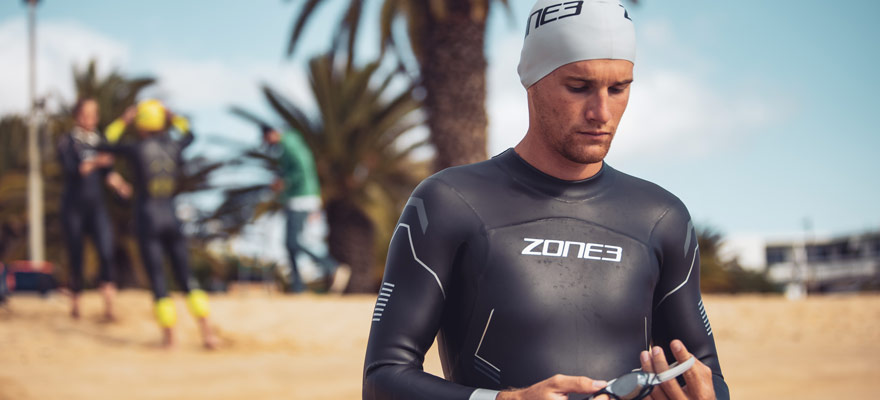How To Care For Your Wetsuit

All Images: Zone3
Once you've purchased your wetsuit, it's crucial to make sure that you properly look after it in order to maximise its lifespan and performance. Whilst there is a lot of technology that goes into wetsuits, they can still be fragile. Smoothskin neoprene, as used in most swimming wetsuits, can be particularly susceptible to damage so it's especially important to make sure that you look after them in the right way.
From washing, to drying, to storage, we've put together what we consider to be some of the most important points to remember when caring for your wetsuit.
Rinse After Every Use
After every use, make sure that you give your wetsuit a thorough rinse. This is especially important if used in saltwater which will damage the suit should you not wash it off.
Best practice is to have a container with you that can be filled with fresh water. You can then take your wetsuit off and put it straight into clean water to be rinsed. Alternatively, you can use a hose pipe or showerhead to rinse the suit off once you are back home.
Begin with the wetsuit inside out before unfolding to rinse the outer side of the suit.
Do Not Use Detergent, Washing Machines or Tumble driers
Do not use detergent on your suit at any point, as it can easily damage the material of your wetsuit. You can purchase specifically made wetsuit shampoo but if your suit is rinsed and dried correctly after every use, there is usually no need for them.
Never put your wetsuit in a washing machine or tumble drier. The heat and spinning will damage your wetsuit and it’s seams.

Avoid chlorine
Where possible, avoid using your wetsuit in chlorinated swimming pools. The chemical is harmful to the suit and prolonged exposure will cause damage. Chlorine will cause the colours of your wetsuit to fade, reduce it’s elasticity and eventually delaminate the suite.
The wetsuits we stock are made for open water and wild swimming, however, if you do use your wetsuit in chlorine, for example if it is required for an event, then ensure that you pay special attention to give it a thorough rinse afterwards.
Keep Velcro covered or done up
Take special care if your suit has any Velcro sections. Either ensure that you have a Velcro cover/patch in place or reattach the Velcro strap whenever you aren’t wearing the wetsuit. This is because open Velcro can easily aggravate and damage the material of your wetsuit.
Drying Your Wetsuit
Fully drying your wetsuit is crucial to increasing its lifespan and preventing any mould growth. Dry your wetsuit inside out initially. Once the inside is completely dry, flip the suit out the correct way, and ensure you go through the same drying process for the outside of the suit.
It is possible to damage your wetsuit when drying, so here are some important points to consider:
- Avoid direct sunlight - Drying the wetsuit in direct sunlight will eventually cause damage thanks to UV. With prolonged drying in the sun, you’ll damage the seams and find that the suit begins to crumble and go crusty. Instead try to dry your suit in shaded areas, or indoors.
- Avoid heat sources - Putting your wetsuit under too much heat will quickly cause damage, most notably to glued seams.
- Avoid coat hangers - It is best to avoid drying the wetsuit on a hanger placed through the shoulders. This is because with the added weight of water in the suit, you can easily stretch it out and put additional stress on the (usually) thin shoulder areas. Ideally, you want to dry the suit with it gently folded at the waist area. If you need to hang your suit, then you can purchase wetsuit specific hangers which are much wider than standard, reducing pressure on the suit.

How to store your wetsuit
Once dried, the ideal way to store your wetsuit is for it to be laid down flat, however, thanks to taking up quite a bit of space, it isn’t always practical for everyone. There are a couple of alternative options you can use to ensure your suit stays in top condition for its next use.
If storing your wetsuit on a hanger, try to use one with a flat bar. You can then place a folded towel over the bar, before putting your wetsuit through so that it is folded at the waist. By placing the towel on the bar, you increase the size of the fold and reduce stress on the wetsuit.
If you aren’t able to hang your wetsuit, then you can simply fold the arms diagonally down the bag, fold the legs at the knees, and then fold the whole suit in half. This is the best way to ensure minimal stress is put on your suit from the folds. When travelling with your wetsuit in a bag, this is also the best way to keep your suit.
About the Author:Huw Saunders - Outdoor ExpertGrowing up in rural Wales, Huw has been immersed in the outdoors for as long as he can remember. If not surfing the Welsh coast, he can now usually be found either running or hiking in the Peak District and through the winter, tries to get out to Europe to ski as much as possible. |









